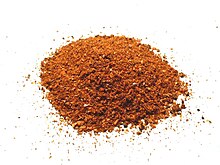| Aleppo pepper | |
|---|---|
 Aleppo pepper, in its typical processed form | |
| Species | Capsicum annuum |
| Origin | South America |
| Heat | |
| Scoville scale | 10,000 SHU |
The Aleppo pepper (Arabic: فلفل حلبي, ALA-LC: fulful Ḥalabī; Turkish: Halep biberi) is a moderately spicy variety of Capsicum annuum used as a spice, particularly in Turkish, Middle Eastern and Mediterranean cuisine. Also known as the Halaby pepper,[1] its pods are ripened to a burgundy color, then semi-dried, de-seeded, and crushed or coarsely ground.[2] The pepper flakes are known in Turkey as pul biber (pul = flake, biber = pepper), and in Armenia as Halebi bibar. In Turkey, pul biber is the third most commonly used spice, after salt and black pepper. In Arabic, the pepper is named after Aleppo, a long-inhabited city along the Silk Road in northern Syria, and is grown in Syria and Turkey. Chiles originated in South America and were among the New World crops, like potatoes and tomatoes.[3]
Although a common condiment, its use in Europe and the United States outside Armenian, Syrian and Turkish immigrant communities was rare until the 20th century, with one source (Los Angeles magazine) dating its rise in use among the broader U.S. population according to the 1994 publication of The Cooking of the Eastern Mediterranean by Paula Wolfert.[4]
- ^ "Chiles You Haven't Heard of but Soon Will". www.spicesinc.com. Retrieved 2018-08-28.
- ^ Cite error: The named reference
foundrywas invoked but never defined (see the help page). - ^ Verde, Tom (2018-10-09). "The Long Journey of the Aleppo Pepper". The New York Times. ISSN 0362-4331. Retrieved 2024-06-20.
- ^ "Hot Stuff". Los Angeles. Connoisseur Corner. May 2002. Archived from the original on 2010-02-27. Retrieved 2010-10-20.